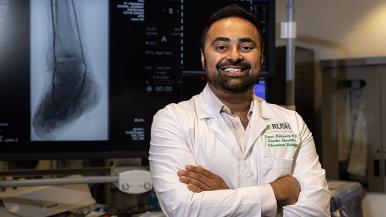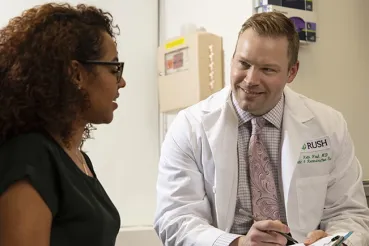Major limb amputation is a life-altering procedure. It can also be deadly, with a 60% mortality rate over five years in patients with a major amputation due to untreated critical limb ischemia from peripheral arterial disease. And, as the limb preservation services team at RUSH has seen, many amputations can be prevented.
In 2021, Rabbi Howard Berger was told he was in danger of losing his foot after a small wound became infected. Ischemia, or reduced blood flow, caused blockages of the blood vessels in his foot, which had kept the wound from healing.
“The thing I want to make clear is that I was told in so many words that nothing would have worked to stop the infection without restoring the circulation,” Berger said. “So, I would have lost my foot, or part of my foot.”
Ischemia can occur for many reasons, including diabetes, heart and vascular disease, and certain cancers. Critical limb ischemia leads to amputation for 22% of patients within a year of diagnosis.
Alternatives to amputation
A RUSH podiatrist, Dean Stern, DPM, said he could attempt to treat Berger’s infection, but only if circulation in his foot could first be restored. The podiatrist recommended Sreekumar Madassery, MD, and the team with RUSH’s limb preservation services.
“The podiatrist said that the best person in the region, and possibly the country, is Dr. Madassery,” Berger said. “He walked out of the room and called Dr. Madassery, and I got an appointment at RUSH right away to see him.”
Madassery, a vascular interventional radiologist, said there are many patients like Berger who are looking for alternatives to amputation — and that more than 70% of those who come to RUSH’s limb preservation team end up preserving their limbs, due to the innovative and complex revascularization techniques that are performed with his team. They were the first in the region to selectively perform deep vein arterializations (DVA), a true last option for those previously considered to be “no option” patients.
“If a patient is told that they have an arterial disease and there’s nothing that can be done to save the limb (i.e. “no option” or “desert foot”), always, always ask for a second or third opinion from a high-level expert,” Madassery said. “There are situations that the limb does need to removed, but for far too many, that should have been a last resort after everything else is exhausted. Never be told there’s nothing that can be done. Similar to cancer patients seeking second and third opinions, patients facing limb amputation should do the same.”
'Monitor your feet and ask questions'
Madassery said that patients with ischemia should remain observant and see a doctor quickly if they are concerned about changes with their legs or feet.
“Patients with ischemia should regularly see podiatrists for foot problems,” Madassery said. “Any time you see a wound, get in and get it looked at. There are additional risk factors, such as nutrition and smoking. But you should constantly monitor your feet and ask questions.”
By January 2022, after two procedures to unblock blood vessels in Berger’s foot, circulation had been completely restored. Following several months of wound treatment and care, Rabbi Berger is now completely recovered and back to his normal life.
“I have a complete foot thanks to the work that he did,” he said.




